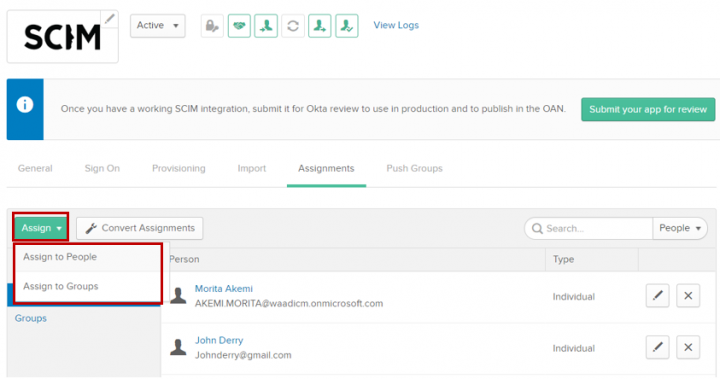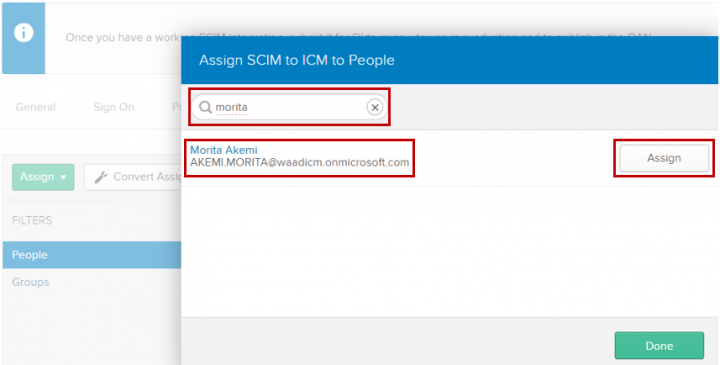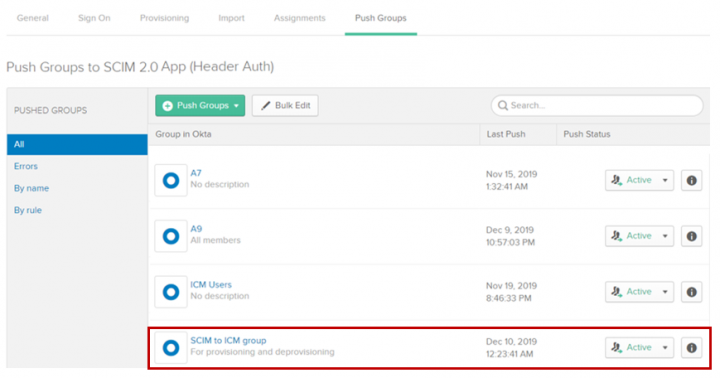| Line 69: | Line 69: | ||
<div class="image-green-border">[[File:7.10 SCIM 13.png|720px|7.10 SCIM 13.png]]</div> | <div class="image-green-border">[[File:7.10 SCIM 13.png|720px|7.10 SCIM 13.png]]</div> | ||
| | ||
| + | |||
=== Provisioning users using assignment === | === Provisioning users using assignment === | ||
| Line 92: | Line 93: | ||
<div class="image-green-border">[[File:7.10 SCIM 17.png|720px|7.10 SCIM 17.png]]</div> | <div class="image-green-border">[[File:7.10 SCIM 17.png|720px|7.10 SCIM 17.png]]</div> | ||
The user is assigned and provisioned in ICI. | The user is assigned and provisioned in ICI. | ||
| − | <div class="image-green-border">[[File: | + | <div class="image-green-border">[[File:8.0SCIM27.PNG|720px]]</div> |
| | ||
Revision as of 07:20, 20 December 2021
Contents
System for Cross Domain Identity Management (SCIM)
ICI is now providing support for System for Cross-domain Identity Management (SCIM), which is an open standard protocol to automate the provisioning and deprovisioning of users. This framework allows exchange of user identity and user group information between identity providers (such as OKTA) and service providers (such as ICI – SaaS-based application). As a single system is used to manage permissions and groups, and data is transferred automatically, the risk of error is considerably reduced. This makes user management simpler and easier for customers.
OKTA integrates various applications into its service, and you simply deploy these pre-integrated applications to your users as necessary. For example, OKTA uses the SCIM application to provision users or user groups in ICI.
To provision or deprovision ICI users, the OKTA Administrator first needs to create and configure an application which supports the SCIM protocol.
Configuring the SCIM Application
The OKTA Administrator uses the OKTA Dashboard to configure the SCIM application.
1. Click the Applications tab.
2. Select Applications from the drop-down. The Applications page opens.
4. Enter scim in the search field to search applications that are supporting SCIM.
5. Select the application created by the OKTA Administrator using SCIM 2.0 App (Header Auth) for SCIM protocol. For example, SCIM to ICI application (as shown in the screenshot below):
To configure SCIM to ICI application, the OKTA Administrator performs the following steps:
1. Click the Provisioning tab.
2. Click the Integration tab.
3. Enter the Base URL and API Token as provided by ICI Administrator.
4. Click the Test API Credentials button to validate the credentials (ICI Base URL and API Token). A validation message will be displayed on entering incorrect credentials indicating that an authentication error has occurred.
To allow Provisioning of SCIM application i.e. from OKTA to SCIM, the Administrator enables functionalities such as Create Users, Update User Attributes, and Deactivate Users. After enabling the functionalities, you can provision/deprovision users in ICI from OKTA using the SCIM protocol (for example, SCIM to ICI application as mentioned in Step 5).
Adding a user in OKTA
To add a user in OKTA:
1. Click Users menu on the Dashboard.
2. Click People.
3. Click Add Person. The Add Person window opens.
4. Enter details such as First name, Last name, Username and Primary email. For example, add user - Michael Smith.
5. Click Save. The user Michael Smith is added to the application SCIM to ICI.
6. The user Michael Smith can now be provisioned to ICI using Assignments tab.
Provisioning users
You can provision users by adding users individually or by user group in ICI:
1. Click theAssignments tab.
2. Click Assign drop-down.
3. Select Assign to People to select an individual user or select Assign to Groups to select a user group.
Provisioning users using assignment
To add a user to SCIM to ICI Assignments:
1. Click the Assignments tab in the Applications menu.
2. Click the Assign drop-down.
3. Click Assign to People. The Assign SCIM to ICI to People window opens.
4. Search for a user in the search tab. For example, Morita Akemi.
5. Click Assign.
- If the user is not present, ICI creates a new user.
- If the user is present, but in the deprovisioned state, then ICI reprovisions the user only if the External identifier value in ICI is matching with the value of SCIM External identifier.
6. Click Save and Go Back.
7. Click Done.
The user is assigned and provisioned in ICI.
Provisioning users using group assignment
Group assignment in SCIM is a convenient way to get multiple assignments. Using SCIM Group, users are provisioned to ICI in one go. You can create User Groups in ICI using Add Group functionality of SCIM.
You can provision multiple users in ICI by using a group assignment provided they are already assigned and displayed in the Assignments tab.
To add already assigned members to a group SCIM to ICI group:
1. Click SCIM to ICI group.
2. Click Manage People.
3. Search a user. For example, Michael Smith should already be provisioned in ICI through an individual or group assignment.
4. Click the Add icon.
5. Click Save. The user Michael Smith is added to the group SCIM to ICI group.
Mapping ICI attributes with SCIM attributes
To map ICI attributes with SCIM attributes, you must create the Client App Entity Mapping.
Client App Entity Mapping
1. Click "Configure" > "Masterdata" on the Home page. The Masterdata index page opens.
2. Click "Create". The "Create Masterdata" page opens.
The Create Masterdata page contains the following tabs:
a. Masterdata Details
b. Attributes
a. Masterdata Details
1. Select the Category from the drop-down. For example, Default.
2. Select the Masterdata Contract Type.
3. Click Next. The Attributes page opens.
b. Attributes
Provide relevant attribute values in the respective fields:
Note:
- It is mandatory to create the Client App Entity Mapping for the attribute ExternalUPN.
- Repeat the steps under Client App Entity Mapping to map other attributes such as Phone Number from SCIM to ICI.
The Client App Entity Mapping created is displayed as shown in the screenshot below:
The value of the SCIM attribute name (for example, userName) is mapped with ICI attribute name (for example, ExternalUPN) as shown in the screenshot below:
In this example, the value of Client Attribute Name as shown in the above screenshot is mapped to the Org Path Mapping masterdata.
Using the Client App Entity Mapping for attributes such as OrganizationUnitId, OrgPathId or SharedOrgPathId, the Org Path Mapping will be used to map the respective Org of a user.
Deprovisioning users
You can deprovision users in ICI using the Assignments tab.
Deprovisioning user from assignment
You can deprovision user either individually or by removing the user from the group which was used as assignment.
To deprovision an assigned user from SCIM:
2. Select the user to be unassigned from the displayed records. For example, Michael Smith.
3. Click OK.
The user Michael Smith is unassigned from SCIM to ICI and subsequently deprovisioned from ICI.
Creating User Groups in ICI using SCIM
To create user groups in ICI using SCIM, you must create the SCIM Groups Mapping masterdata.
The SCIM Groups Mapping masterdata is created to define the mapping before pushing the group from SCIM to ICI, for example, to push the Group SCIM Admins from SCIM to ICI as Local Admins. If the mapping is not present, the Group SCIM Admins will be created as Group SCIM Admins in ICI, and a masterdata record will also be created in SCIM Groups Mapping masterdata if the masterdata Contract Type is available.
SCIM Groups Mapping
1. Click the Configuration tile. The Configuration page opens.
2. Click the Masterdata tile. The Masterdata page opens.
3. Click the Create Masterdata tile. The Create Masterdata page opens.
The Create Masterdata page contains the following tabs:
a. Masterdata Details
b. Attributes
a. Masterdata Details
1. Select the Category from the drop-down. For example, Default.
2. Select the Masterdata Contract Type.
3. Click Next. The Attributes page opens.
b. Attributes
- Enter the masterdata Name (such as SCIM to ICI group) and the SCIM Group Name (such as SCIM to ICI group).
- Click Save.
The SCIM Groups Mapping created is displayed as shown in the screenshot below:
To create User Group using SCIM:
1. Click the Users tab on the OKTA Dashboard.
2. Select Groups from the drop-down menu. The Groups page opens.
3. Click Add Group.
4. Enter Name. For example, SCIM to ICI group.
5. Click Add Group. The group is added in SCIM.
Push Groups:
Push Group is used to create User Groups in ICI. You can push groups with members, but the member should have already been provisioned in ICI using Assignment either individually or group assignment.
6. Click the Push Groups tab.
7. Click the Push Groups drop-down.
8. Search a group using the search field. For example,SCIM to ICI group.
9. Select the desired group from the displayed records.
10. Click Save. The SCIM to ICI group is now pushed to ICI.
11. The members of the group SCIM to ICI group are pushed to ICI. For example, the user of the group SCIM to ICI group Michael Smith is pushed to ICI.
Managing ICI User Group members using SCIM
To deprovision a user using SCIM, you first need to remove the user from the Push Groups. For example, let us remove the user Michael Smith from Push GroupsSCIM to ICI group.
1. Go to the Push Groups tab.
2. Click the Push Groups. For example, SCIM to ICI group.
3. Click Manage People. The SCIM to ICI group opens.
4. Click the remove icon for the user to be removed. For example, Michael Smith.
5. Click Save. The user is removed from the Push Group - SCIM to ICI group and consequently gets deprovisioned from the User Groups in ICI.












































